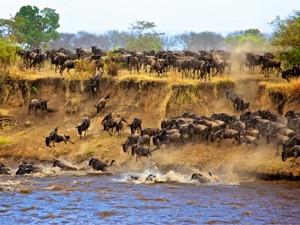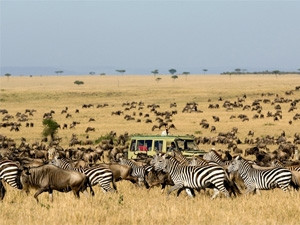
The new HerdTracker app plots the position of the massive herds using updates sent in by pilots and rangers in Kenya and Tanzania. The aim is to help people decide which lodges to visit and when, to make sure they don't miss this amazing event, says Andre van Kets, co-founder of Cape Town-based Discover Africa.
The app was developed by its in-house technical team using open source software, taking two months to complete along with a general overhaul of the company's website.
The technology is simple but nobody has used it for tracking wildebeest before, Van Kets says. "It's not groundbreaking technology. We've used open source tools and Google Maps, which has an open API, although we used our own icons, not the standard set. We've combined that with the human element so we're not just posting the GPS coordinates, but the comments of our guides too."
Authenticity
Pins in the HerdTracker map have a little image of a wildebeest on them, and clicking a pin displays the message from whoever called in the update. The news comes in from pilots who fly over the Serengeti, trackers on the ground, lodges in Kenya's Masai Mara and rangers with the Tanzania National Parks Authority. One recent update from Mashine, a safari guide at Ewanjan Lemala Camp in the Serengeti, reads: "We haven't started our morning game drive yet because the migration is right here. I drove through the herds yesterday afternoon - clients are happy!"
Another contributor is Captain Joel Fernandes, a pilot for Coastal Aviation in Tanzania, who flies over the Serengeti every day. "Joel takes photographs and e-mails them through, and we don't edit his comments so they're as authentic as possible," says Van Kets.
The big problem in planning a Serengeti excursion is that wildebeest don't migrate according to any human calendar. So you could spend a fortune and still miss the stunning sight of millions of beasties trekking across the plains and plunging into rivers where crocodiles lie in wait.
"We wanted to launch our new site with something truly useful, and the biggest problem to solve in the migration tourism space is that people are spending a lot of money on what's probably a once-in-a-lifetime holiday and they're scared of missing it by a week," Van Kets says. "It's that fear we're hoping to address."
The news comes in from pilots who fly over the Serengeti, trackers on the ground, lodges in Kenya's Masai Mara and rangers with the Tanzania National Parks Authority.
By receiving regular updates from the ground, the team can predict the movement of the herds and design the optimum trip.
The idea came from safari guide Carel Verhoef, who was born in the Kruger and lived in the Serengeti for ten years. He has led more than 300 migration safaris but is now based in Cape Town and runs HerdTracker from there.
Monthly predictions
It's only available as a web app so far, but it's very user-friendly because it was designed for browsing on a phone rather than a computer. "We designed it to be mobile first, because if you first build a desktop version and try to shrink it to mobile, it's really difficult. It's better to build it for a small screen and then scale it up," Van Kets says.
The team is now considering developing an Android app version that would push updates to its users without them needing to log onto the Web site.

Herdtracker was launched on April 22 and was used by 1 465 people in the first three weeks. Updates are also posted on Twitter via @HerdTracker, along with postings from an anthropomorphic wildebeest called Conrad. "That's a little bit of fun and edutainment, telling the story of what it's like out there with the interactions with lions and crossing the rivers. I don't know if wildebeest actually feel fear while they're crossing the rivers, but we've tried to create a character to tell the story," Ven Kets says.
HerdTracker will also debunk the myth that the migration only happens once a year, because the website features a month-by-month guide to where the herds are to be found. People can consult those monthly predictions of the migratory movements, and see which lodge to visit for the best experience. Verhoef updates those predictions based on the updates from the Serengeti and his knowledge of previous migratory patterns.
HerdTracker's migration map is at www.discoverafrica.com/herdtracker and on Twitter @HerdTracker.
First published in the July 2014 issue of ITWeb Brainstorm magazine.
Share